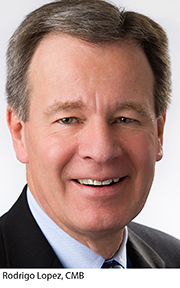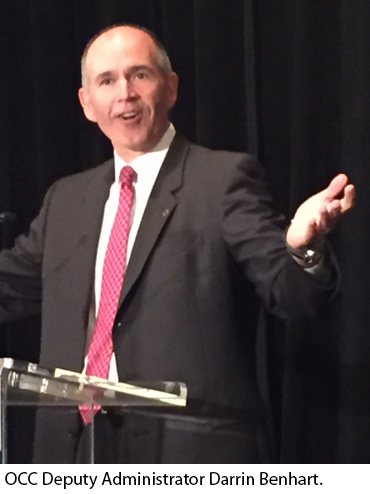
Lopez Urges Vigilance in ‘High-Risk’ Environment
MIAMI–Financial regulators are focusing intently on lenders’ risk management organizations and practices. So is the Mortgage Bankers Association.
“Strong risk management is essential to the strategic vision of every business in our industry,” said MBA Chairman Rodrigo Lopez, CMB, executive chairman of NorthMarq Capital Finance, Omaha, Neb. “Your roles are critical to the success of your companies and our industry.”
 Lopez, speaking here at the Risk Management, QA and Fraud Prevention Forum, noted with interest rates projected to rise, the purchase market will continue to grow. “With interest rates having risen, albeit from their record lows, and refinance volume falling away, all eyes are on growth in the purchase market to sustain lending business,” he said. “With the positive economic job and wage indicators, and a huge cohort of millennials entering the housing market, now is the perfect time for originators to evolve with new products and approaches to expand their businesses.”
Lopez, speaking here at the Risk Management, QA and Fraud Prevention Forum, noted with interest rates projected to rise, the purchase market will continue to grow. “With interest rates having risen, albeit from their record lows, and refinance volume falling away, all eyes are on growth in the purchase market to sustain lending business,” he said. “With the positive economic job and wage indicators, and a huge cohort of millennials entering the housing market, now is the perfect time for originators to evolve with new products and approaches to expand their businesses.”
Lopez said lenders are increasingly looking to automation to expand products and services. “We are now eight years since the financial crisis,” he said. “The memories, pains and problems are still fresh. We have to remember the lessons learned and we must be thinking strategically, utilizing sound risk management practices and quality control processes. In short, this all puts enormous pressure on those who manage risk. It’s up to you, the people in this room, to find the right balance.”
Lopez noted with the shifting business in mind, many lenders are looking to reengineer their processes and make technological advancements to reach more consumers in more efficient ways.
“This is happening at an extraordinary pace,” Lopez said. “They are expanding into e-mortgage, digital mortgage and automated verification of income and assets. Fannie Mae and Freddie Mac recently announced the increasing use of automated valuations for homes with certain qualifying loans.”
Because of the fast pace of advancement, Lopez said lenders and servicers must rethink how you do your jobs. “You are aiming to control costs, improve the customer experience, keep pace with technological advancements and all without reducing quality or increasing the risks,” he said.
“Cybersecurity is one of the most serious risks we face today,” Lopez said. “Look at the Equifax breach of over 143 million people this month. Some of the information hackers got access to include names, Social Security numbers, birth dates, addresses and some driver’s license numbers. They also accessed some of the company’s customers’ credit card information. These types risks are growing exponentially and financial institutions are a frequent target with many entry points and a lot of data.”
Lopez said as the industry looks ahead to expanded Home Mortgage Disclosure Act requirements coming on line in 2018, “massive” amounts of data companies are gathering and will be required to transfer to the federal government could be subject to cyber-attacks.
“We must recognize this as a potential cyber target and work to protect this information,” Lopez said. “Something bad will happen. The question is, are we prepared? How do we increasingly utilize technology to lower costs, improve quality, meet regulatory requirements, all the while being mindful of the added risks?”
Lopez said today’s market creates strategic opportunities for grown and technological advancement for the industry. “But we must also be mindful and strategic with risk management and quality assurance practices as we move forward,” he said. “We must recognize the inevitable risks of cyber-attacks and work collectively to combat them.”
A united real estate finance industry is necessary to influence public policy, Lopez added. “But also to take advantage of transformational business opportunities. Collectively we can achieve the best results for our companies, customers and the industry as a whole.”
 Darrin Benhart, deputy comptroller for supervision risk management with the Office of the Comptroller of the Currency, said with a changing single-family and multifamily housing environment, consumer leverage is increasing.
Darrin Benhart, deputy comptroller for supervision risk management with the Office of the Comptroller of the Currency, said with a changing single-family and multifamily housing environment, consumer leverage is increasing.
“We ask ourselves, ‘why do cycles end?'” Benhart said. “In many cases, it’s because leverage changes. And we’re seeing consumers gaining leverage in the housing market.”
Pre-Great Recession, Benhart said, consumers enjoyed substantial leverage, at a price. In the new regulatory environment, that leverage eased, but is coming back as lenders and servicers try to attract more customers.
Take mortgages, for example. Post-crisis, government and GSE increased their market shares significantly, at the expense of banks, thrifts and private mortgage conduits. Mortgage delinquencies and foreclosures have returned to pre-crisis levels.
“There’s an opportunity in the mortgage community for the consumer to gain more leverage,” Benhart said.
But with such opportunities come risk. “Strategic risks remain high for many banks, as management teams consider viable business models,” Benhart said. “We’re seeing many divergent strategies among banks. We’re seeing a lot of merger and acquisition activity, particularly among mid-sized banks, which in and of itself presents some regulatory risks. And net interest margins are likely to remain under pressure, as rates haven’t moved a lot over the past several years.”
Benhart noted banks continue to incrementally ease underwriting practices. “People are being more selective in the credit they underwrite and in the customers they underwrite,” he said. “We’re talking about the terms being offered, but when the terms are extended, those terms are pretty aggressive.”
Sophisticated cyber-threats continue to pose high inherent risks. “Internal controls help avoid phishing, ransomware attacks and viruses and mitigate other risks,” Benhart said. “These are things that Equifax did not do.”
Looking forward, Benhart said there is a “bright, sustainable future for the mortgage industry, as long as we act in a safe and sound manner.”
